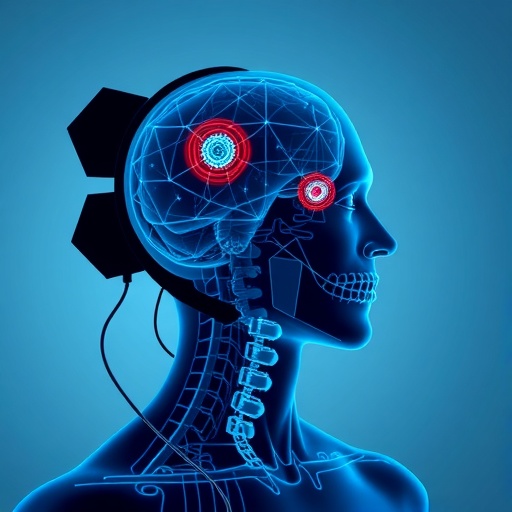In the quest to address the debilitating neuropsychiatric condition known as catatonia, researchers are turning to innovative neuromodulation techniques that may revolutionize treatment paradigms. Catatonia, marked by severe psychomotor disturbances, remains a formidable challenge in psychiatric care due to its significant morbidity and mortality. Although benzodiazepines like lorazepam and electroconvulsive therapy (ECT) have long been the cornerstone treatments, a substantial subset of patients exhibits resistance, particularly those with underlying neurodevelopmental disorders. This conundrum has spurred scientific inquiry into alternative, less invasive therapeutic avenues, catalyzing interest in transcranial direct current stimulation (tDCS).
Transcranial direct current stimulation represents a cutting-edge approach in brain stimulation therapy, utilizing low-intensity electrical currents to modulate neuronal activity non-invasively. Characterized by its cost-effectiveness and safety profile, tDCS has demonstrated promising results in a variety of psychiatric and neurological disorders. Despite limited data, preliminary case reports involving fewer than ten patients have hinted at its potential efficacy in alleviating catatonia. To robustly explore this potential, the CATATOES study—a randomized, double-blind, placebo-controlled bicentric superiority trial—is set to rigorously evaluate the safety and efficacy of tDCS in patients exhibiting lorazepam-resistant catatonia.
The study is designed to enroll seventy individuals who have failed to respond to lorazepam, reflecting an urgent need for alternative interventions. Participants will undergo a comprehensive treatment regimen involving twenty sessions of tDCS, administered twice daily. Each session delivers a current of two milliamperes for twenty minutes, with precise electrode placement that targets specific brain regions implicated in catatonia’s neuropathophysiology. The anode will be positioned over the left dorsolateral prefrontal cortex (DLPFC), a region involved in executive function and motor planning, while the cathode will be placed over the left temporoparietal junction (TPJ), associated with sensory integration and social cognition.
The study’s methodological rigor extends beyond clinical assessments. Multimodal neuroimaging—including structural, functional, and diffusion magnetic resonance imaging (MRI)—will be employed serially to elucidate the neural circuits influenced by tDCS. Complementing imaging, high-density 64-channel electroencephalography (EEG) recordings at rest will provide rich electrophysiological data, potentially revealing biomarkers of treatment response and mechanistic insights. Furthermore, comprehensive blood analyses will track inflammatory markers, neurogenesis-related factors, and genetic variables, offering a molecular dimension to this multifaceted investigation.
Catatonia’s pathophysiology remains incompletely understood, but mounting evidence implicates disruptions in cortico-subcortical circuits and neurotransmitter systems. By focusing stimulation on the DLPFC and TPJ, the CATATOES study targets nodes within these dysfunctional networks, hypothesizing that tDCS may restore cortical excitability and connectivity balance. This hypothesis aligns with broader neuroscientific concepts positing that modulating dysfunctional neural dynamics can ameliorate complex brain disorders. Should tDCS prove efficacious, it would represent a paradigm shift, introducing an accessible, minimally invasive treatment option for refractory catatonia.
The implications of this research extend well beyond symptom remission. Catatonia is associated with significant healthcare burdens, including prolonged hospital stays, increased mortality, and high treatment costs. Conventional options like ECT, while effective, carry risks and face barriers related to stigma, availability, and patient tolerance. Successful demonstration of tDCS as a reliable therapeutic tool could democratize access to care, reduce healthcare costs, and importantly, improve quality of life for a vulnerable patient population. The CATATOES study thereby holds promise for transforming the therapeutic landscape in psychiatry.
In conducting this study across two clinical centers, the research team ensures a sufficiently diverse patient cohort, which enhances the generalizability and robustness of findings. Blinded administration and placebo control safeguard against bias, a critical aspect for maintaining scientific rigor in clinical trials involving subjective and potentially fluctuating neuropsychiatric symptoms. By employing rigorous randomization and double-blind protocols, the study aims to definitively ascertain whether tDCS can outperform sham stimulation in ameliorating catatonia.
Beyond therapeutic outcomes, accompanying mechanistic investigations offer a rare opportunity to deepen understanding of catatonia itself. Combining neuroimaging, electrophysiology, and molecular biology, the study endeavors to unravel fundamental pathophysiological processes. Such insights could pave the way for biomarker development and personalized treatment strategies, advancing precision psychiatry. A more nuanced comprehension of how neural circuits and biochemical pathways interact in catatonia could also inspire targeted interventions for related neuropsychiatric disorders.
The CATATOES trial is registered at ClinicalTrials.gov with the identifier NCT06139432 and commenced recruitment in late 2023. Enrolment and data collection are expected to proceed over the coming years, with outcomes anticipated to contribute substantially to the evidence base for tDCS in neuropsychiatry. The combined expertise of psychiatrists, neuroscientists, and clinical trialists underscores the multidisciplinary nature of this effort, reflecting contemporary approaches to complex brain disorders.
In sum, the CATATOES study represents a bold, methodologically sophisticated foray into employing non-invasive brain stimulation to revolutionize catatonia treatment. By harnessing the neuromodulatory capacity of tDCS, this research has the potential to overcome longstanding challenges posed by lorazepam-resistant cases. Success in this endeavor could ultimately translate into reduced mortality, enhanced patient recovery, and diminished healthcare burden—objectives that resonate profoundly within psychiatry and neurology communities worldwide.
As scientific understanding and technological innovation converge, the mental health field stands on the brink of transformative therapies. The CATATOES trial exemplifies how rigorously designed clinical research can translate emerging neuroscientific insights into practical treatment advances. This study not only addresses an urgent clinical need but also emboldens future translational work aimed at decoding and treating brain disorders with precision, compassion, and innovation.
Subject of Research: Lorazepam-resistant catatonia and efficacy of transcranial direct current stimulation (tDCS) as an alternative therapeutic intervention.
Article Title: CATATOnia treatment with transcranial direct current electrostimulation: protocol of a randomised, double-blind, placebo-controlled bicentric superiority study (CATATOES).
Article References: Moyal, M., Attali, D., Berre, A.L. et al. CATATOnia treatment with transcranial direct current electrostimulation: protocol of a randomised, double-blind, placebo-controlled bicentric superiority study (CATATOES). BMC Psychiatry 25, 949 (2025). https://doi.org/10.1186/s12888-025-07266-5
Image Credits: AI Generated
DOI: https://doi.org/10.1186/s12888-025-07266-5




